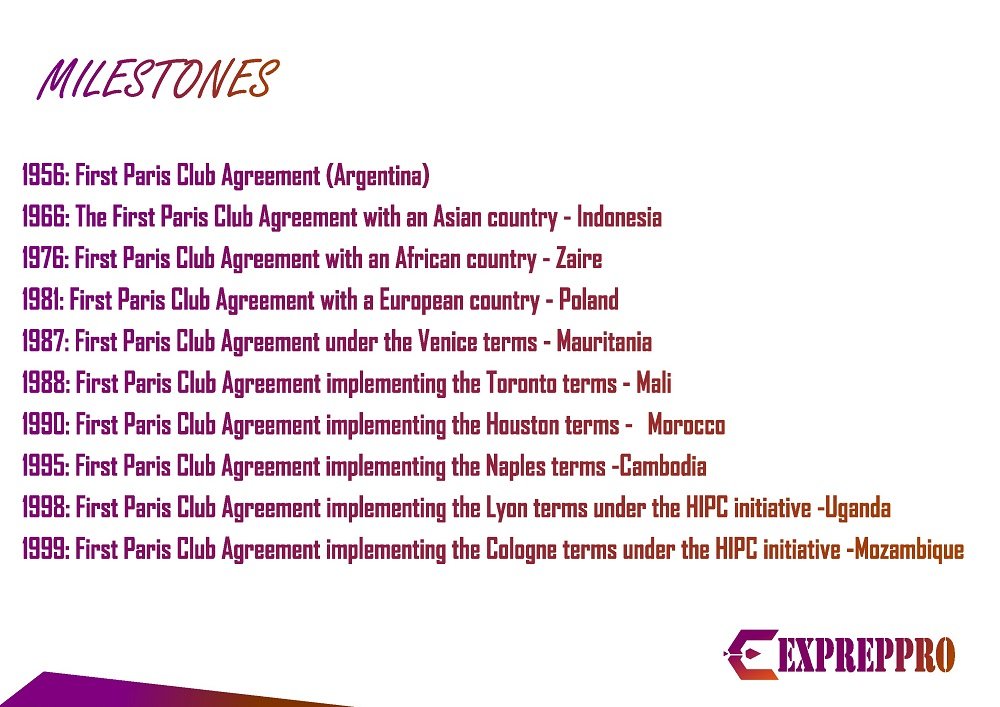
In the fifties, after the world war, the economy all over the world was coming out of war-related problems. The Bretton Woods institutions were in the premature stages and the developing countries were trying to stabilise their economies. In 1955, a sudden military coup displaced the Argentinean president Juan Domingo Peron. The new government was in a hurry to get international recognition. But a problem surfaced ie Debt. Argentina raised the demand to meet its sovereign creditors to prevent a default. At the suggestion of the French minister of economy, an exceptional three-day meeting was hosted in Paris from 14 May to May 16 1956. This meeting resulted in the birth of the Paris Club(the first Paris Club Agreement for Argentina).
HISTORY AND ITS RELEVANCE –
Today, the Paris Club has become a key instrument (along with the IMF and World Bank) in maintaining control of the world economy.
The French Ministry of Finance, rue de Bercy, supports the Paris Club by providing an office for its permanent secretary. The aim is to renegotiate the bilateral public debt of these Southern countries with debt servicing difficulty.
Traditionally, a senior French treasury official will become the Paris Club’s chairman. The current chairman is Mr.Bertrane Dumount. Thirty agreements were signed till 1980 by debtors. Only Argentina, Pakistan, Chile, Brazil, Peru, Indonesia, Cambodia, and Zaire were summoned in the early years. However, the frequency of these summons increased due to the debt crisis at the start of the 1980s. Eighty-three debtor countries signed 378 agreements between 1980 and 2008. Since 1970 Senegal has been called upon fourteen times (Maximum number), followed by Madagascar(twelve times), Niger and D.R. Congo(eleven times). Now, the total number of agreements has increased to 478, the total debtor countries reached 102, and the amount of debt is $614 billion.
MEETINGS AND NEGOTIATIONS –
The plenary meetings occur every month. The delegation from the indebted country and its creditors sit around a round table along with the IMF, World Bank, UNCTAD, and RDB. After the President of the Paris Club starts the proceedings, the leader of the indebted country presents the reasons for their problem. The representatives of creditors may then request additional information.
During the previous months, the indebted country’s government has been in contact with the Paris Club and agreed to accept two stringent conditions.
- Request with the Paris Club based on its impossibility of continuing repayments under present conditions.
- Sign an economic agreement with the IMF to prevent any future debt problems.
After the debt country’s proposal, the creditors agree on a solution. Then, the chairman will present this to the debt county. If they disagree, the process will continue until a consensus is reached. Before the meeting, the indebted country had already agreed to the terms put forward by the creditors. So that on the day of the conference, the delegation has nothing left to negotiate.

AGREED MINUTES –
After reaching a consensus, the chairman, minister of the debt country, and head of delegation of each creditor country sign a document known as the Agreed Minutes. Agreed Minutes is drafted in both English and French.
The debt county should fix a date. Only loans made before that date are affected by the rescheduling, and debts created afterwards are not usually quantified for rescheduling. This mechanism will ensure that newly granted loans will be repaid without any problem. Example- Niger, Cote d’ Ivore, the date was 1/July/1983. Once the terms are finalised, the debtor and creditor sign an agreement.
The club is an informal group with no legal basis. So, the results of discussions are nothing more than suggestions that only come into effect at the creditors’ discretion and willingness to apply them in bilateral agreements. Only bilateral agreements have the law behind them.
SIX PRINCIPLES –
- All members will act in a group.
- Decisions with a consensus.
- Members of the Paris Club regularly share relevant information with other members on the situation of debtor countries.
- Make decisions on a case-by-case basis ( the principle was consolidated by the Evian Approach).
- The club only negotiates debt restructuring with debtor countries that need debt relief, have implemented economic reforms, and have a demonstrated track record of implementing reforms under an IMF program.
- A debtor country with an existing agreement with the Paris Club should not accept loans from its non-Paris Club commercial and bilateral creditors (Can’t accept less favourable conditions).
After appearing before the Paris Club, the debtor can approach the London Club. London Club members are private banks that lend to companies and developing countries (third-world countries). The negotiations and discussions at the London Club are similar to those at the Paris Club but more opaque when compared with their French counterparts.
The club deals differently with the problems faced by struggling countries than it does with those countries with less critical issues. They only reduce the debt for the poorest, and other countries have to go with a rescheduling of debt. Geopolitics also influence their decisions.
CLASSIC TERMS –
Reschedule the ODA or Non-ODA loans at the appropriate market rate with a repayment profile negotiated on a case-by-case basis.
LONDON TERMS –
The level of debt cancellation from 33.33%, as defined in Toronto terms, is increased to 50%. Later, the Paris Club replaced London Terms with Naples terms.
NAPLES TERMS-
Grant two substantial enhancements concerning London terms that can be implemented on a case-by-case basis, on the level of reduction and the conditions of treatment of the debt. Naples terms treatments would get a 67% debt reduction.
COLOGNE TERMS –
Cologne Summit agreed to raise the cancellation level for the poorest countries up to 90% or more if needed in the framework of the HIPC initiative.
LYON TERMS –
Raise the cancellation level up to 80% for the poorest countries with the highest indebtedness with specific contributions of the multilateral institutions to reduce the level of their claims on the concerned countries.
MEMBERS OF PARIS CLUB-
There are 22 members: Australia, Austria, Belgium, Brazil, Canada, Denmark, Finland, France, Germany, Ireland, Israel, Italy, Japan, South Korea, Netherlands, Norway, Russia, Spain, Sweden, Switzerland, U.K, U.S.A.
On 16/May/2019, India became an observer and now an ad hoc participant.
CASE OF POLAND –
In 1991, Poland approached the Paris Club for debt restructuring (Almost $30 Billion). Thus, Poland became the first East European nation to join the West by leaving the Warsaw Pact. However, their debt increased from $183 million in 1990 to $353 million in 1991 and $779 million in 1993. Ultimately, their president, Lech Walesa, protested against the club’s decisions and their poor rewards.
CASE OF EGYPT –
In 1991, Egypt’s $21 billion debt was rescheduled (due to the Gulf War). The Club halved Egypt’s service on debt from $1.14 billion to $555 million in 1991. But later, debt stock continued to increase.
CASE OF GABON –
Gabon, a natural resource-rich African country, went to the Paris Club, and due to the French influence, they got favourable treatment. Gabon paid off its debt at its market value (it was 15% less than its nominal value). Later, France announced a more significant cut of 20% on the part held by France. The difference was converted into investments to save forest (a considerable source of Gabonese wealth), and the creditors monopolised their profits. In reality, the clandestine grip of creditors trapped the Gabonese economy. The population get nothing from their resources, and a large population still lives in poverty.
